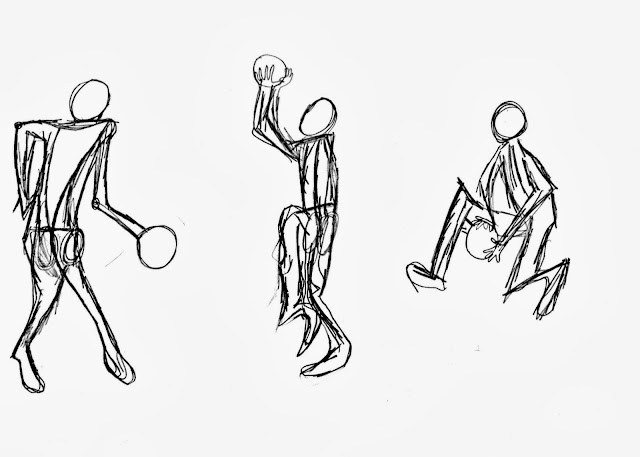Print out the grid below on a piece of clear plastic. Place the plastic over a picture of a person running, jumping or moving and use a dry erase Expo marker to create your gesture drawing. Then copy your drawing on to a separate piece of paper with a pencil. If you are still having trouble, print an identical copy of the grid on white paper and just make sure that every line you draw starts and ends in the correct corresponding box. Once you are used to creating gesture drawings you will not need to use the grid at all.
Make sure that you draw the circles for all the joints in the correct places. Is one shoulder higher than the other? Which foot is he using to push his weight off of the floor? Which foot will he put his weight on when he lands?
Remember, learning how to draw means learning how to see. Using this method will teach you how to accurately observe the way a human figure is moving.
Keep in mind that the legs are half the size of the entire body. Prior to instruction, most students draw the arms and legs too short and the head too big. If you are not already comfortable drawing the human figure using realistic proportions please click on the link below to go to my lesson on geometric figure drawing:
The far shoulder and forearm of this figure are hidden by his body.
A Series of gesture studies by an 8th grade student illustrates the learning process.
His second drawing (middle) is exceptional because he figured out how to overlap the right and left limbs to create a profile figure. He also was able to convincingly foreshorten one of the legs. The action line is clearly visible.
His final drawing, on the right, shows accurate proportions, foreshortening and a fluid sense of movement.
For more practice with gesture drawing click on the links below:
The video below provides two minute poses for gesture drawing practice:
Below is a YouTube playlist that I have created highlighting some ways that artists explore gesture and movement through dance, animation and film:
Student Art Gallery
Gesture drawing silhouettes on watercolor paper.
The silhouettes were painted with black acrylic paint. The backgrounds were created using diluted tempera paint washes on wet watercolor paper and lifting up the paper vertically to allow the colors to drip and blend.


























Great lesson on gesture drawing thank you for sharing it.
ReplyDeleteWonderful collection of teaching aids. Thank you.
ReplyDeleteA place of reference for Art teachers
ReplyDeleteUsing it in my high school class :)
ReplyDelete